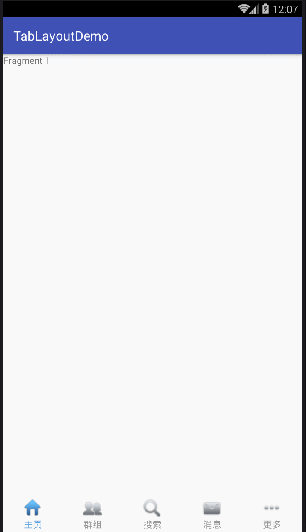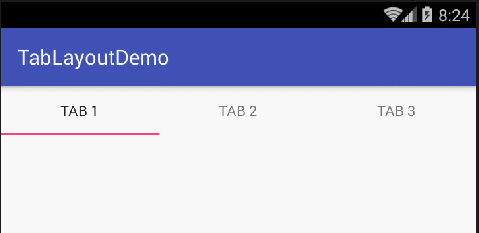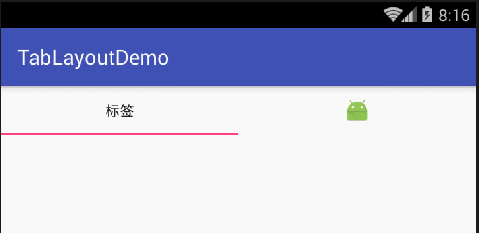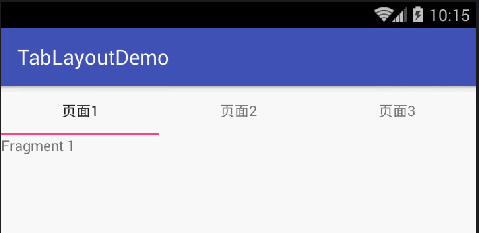转自:https://blog.csdn.net/qq_33425116/article/details/52599818
TabLayout
一、继承结构
public class TabLayout extends HorizontalScrollView - 1
java.lang.Object
↳ android.view.View
↳ android.view.ViewGroup
↳ android.widget.FrameLayout
↳ android.widget.HorizontalScrollView
↳ android.support.design.widget.TabLayout
二、TabLayout的使用
1、TabLayout简单使用
- TabLayout来自design兼容包,使用需要添加依赖。android studio 添加依赖如下:
dependencies {
~~~
compile 'com.android.support:appcompat-v7:23.4.0'
compile 'com.android.support:design:24.2.0'
}- 1
- 2
- 3
- 4
- 5
- TabLayout可以水平放置一些tab标签
- 标签的展示通过 TabLayout.Tab的实例来实现,通过 newTab()方法可以创建这些示例,并且可以通过 setText(int)和setIcon(int)方法分别设置标签的文本的图标。 另外,需要通过layout的setTab(Tab)方法把一个标签展示出来。例如:
tabLayout = (TabLayout)findViewById(R.id.tablayout);
tabLayout.addTab(tabLayout.newTab().setText("Tab 1"));
tabLayout.addTab(tabLayout.newTab().setText("Tab 2"));
tabLayout.addTab(tabLayout.newTab().setText("Tab 3"));- 1
- 2
- 3
- 4
效果:
你需要通过setOnTabSelectedListener(OnTabSelectedListener)方法,来给标签的选择改变设定一个监听器。当选择状态改变的时候,会通知你的监听器。
你在布局中也可以通过使用TabItem标签给TabLayout设置子标签,例如:
<android.support.design.widget.TabLayout
android:layout_width="match_parent"
android:layout_height="wrap_content">
<android.support.design.widget.TabItem
android:layout_width="wrap_content"
android:layout_height="wrap_content"
android:text="标签" />
<android.support.design.widget.TabItem
android:layout_width="wrap_content"
android:layout_height="wrap_content"
android:icon="@mipmap/ic_launcher" />
</android.support.design.widget.TabLayout>- 1
- 2
- 3
- 4
- 5
- 6
- 7
- 8
- 9
- 10
- 11
- 12
- 13
- 14
效果如下:
ViewPager+TabLayout实现导航效果
目标效果一:
方法一:
如果你将TabLayout与ViewPager一起使用,你可以通过调用setupWithViewPager(ViewPager)方法来绑定绑定两个控件。TabLayout将自动出现在ViewPager的标题位置。
方法如下:
MainActivity.java
package com.noonecode.tablayoutdemo;
import android.support.design.widget.TabLayout;
import android.support.v4.app.Fragment;
import android.support.v4.app.FragmentManager;
import android.support.v4.app.FragmentPagerAdapter;
import android.support.v4.view.ViewPager;
import android.support.v7.app.AppCompatActivity;
import android.os.Bundle;
import java.util.ArrayList;
import java.util.List;
public class MainActivity extends AppCompatActivity {
private TabLayout tabLayout;
private ViewPager viewPager;
private List<Fragment> list;
private MyAdapter adapter;
private String[] titles = {"页面1", "页面2", "页面3"};
@Override
protected void onCreate(Bundle savedInstanceState) {
super.onCreate(savedInstanceState);
setContentView(R.layout.activity_main);
//实例化
viewPager = (ViewPager) findViewById(R.id.viewpager);
tabLayout = (TabLayout) findViewById(R.id.tablayout);
//页面,数据源
list = new ArrayList<>();
list.add(new Tab1Fragment());
list.add(new Tab2Fragment());
list.add(new Tab3Fragment());
//ViewPager的适配器
adapter = new MyAdapter(getSupportFragmentManager());
viewPager.setAdapter(adapter);
//绑定
tabLayout.setupWithViewPager(viewPager);
}
class MyAdapter extends FragmentPagerAdapter {
public MyAdapter(FragmentManager fm) {
super(fm);
}
@Override
public Fragment getItem(int position) {
return list.get(position);
}
@Override
public int getCount() {
return list.size();
}
//重写这个方法,将设置每个Tab的标题
@Override
public CharSequence getPageTitle(int position) {
return titles[position];
}
}
}- 1
- 2
- 3
- 4
- 5
- 6
- 7
- 8
- 9
- 10
- 11
- 12
- 13
- 14
- 15
- 16
- 17
- 18
- 19
- 20
- 21
- 22
- 23
- 24
- 25
- 26
- 27
- 28
- 29
- 30
- 31
- 32
- 33
- 34
- 35
- 36
- 37
- 38
- 39
- 40
- 41
- 42
- 43
- 44
- 45
- 46
- 47
- 48
- 49
- 50
- 51
- 52
- 53
- 54
- 55
- 56
- 57
- 58
- 59
- 60
- 61
- 62
- 63
- 64
activity_main.java
<?xml version="1.0" encoding="utf-8"?>
<LinearLayout xmlns:android="http://schemas.android.com/apk/res/android"
xmlns:tools="http://schemas.android.com/tools"
android:layout_width="match_parent"
android:layout_height="match_parent"
android:orientation="vertical"
tools:context="com.noonecode.tablayoutdemo.MainActivity">
<android.support.design.widget.TabLayout
android:id="@+id/tablayout"
android:layout_width="match_parent"
android:layout_height="wrap_content" />
<android.support.v4.view.ViewPager
android:id="@+id/viewpager"
android:layout_width="match_parent"
android:layout_height="0dp"
android:layout_weight="1">
</android.support.v4.view.ViewPager>
</LinearLayout>- 1
- 2
- 3
- 4
- 5
- 6
- 7
- 8
- 9
- 10
- 11
- 12
- 13
- 14
- 15
- 16
- 17
- 18
- 19
- 20
方法二:
TabLayout也支持当作ViewPager的装饰来使用,通过在布局中直接把它添加到ViewPager的内部(将自动将ViewPager的标题作为TabLayout的Tab)。
如下方式使用:
MainActivity.java
package com.noonecode.tablayoutdemo;
import android.support.design.widget.TabLayout;
import android.support.v4.app.Fragment;
import android.support.v4.app.FragmentManager;
import android.support.v4.app.FragmentPagerAdapter;
import android.support.v4.view.ViewPager;
import android.support.v7.app.AppCompatActivity;
import android.os.Bundle;
import java.util.ArrayList;
import java.util.List;
public class MainActivity extends AppCompatActivity {
private ViewPager viewPager;
private List<Fragment> list;
private MyAdapter adapter;
private String[] titles = {"页面1", "页面2", "页面3"};
@Override
protected void onCreate(Bundle savedInstanceState) {
super.onCreate(savedInstanceState);
setContentView(R.layout.activity_main);
//实例化
viewPager = (ViewPager) findViewById(R.id.viewpager);
//页面,数据源
list = new ArrayList<>();
list.add(new Tab1Fragment());
list.add(new Tab2Fragment());
list.add(new Tab3Fragment());
//ViewPager的适配器
adapter = new MyAdapter(getSupportFragmentManager());
viewPager.setAdapter(adapter);
}
class MyAdapter extends FragmentPagerAdapter {
...
//重写这个方法,将设置每个Tab的标题
@Override
public CharSequence getPageTitle(int position) {
return titles[position];
}
}
}- 1
- 2
- 3
- 4
- 5
- 6
- 7
- 8
- 9
- 10
- 11
- 12
- 13
- 14
- 15
- 16
- 17
- 18
- 19
- 20
- 21
- 22
- 23
- 24
- 25
- 26
- 27
- 28
- 29
- 30
- 31
- 32
- 33
- 34
- 35
- 36
- 37
- 38
- 39
- 40
- 41
- 42
- 43
- 44
- 45
- 46
- 47
- 48
- 49
activity_main.java
<?xml version="1.0" encoding="utf-8"?>
<LinearLayout xmlns:android="http://schemas.android.com/apk/res/android"
xmlns:tools="http://schemas.android.com/tools"
android:layout_width="match_parent"
android:layout_height="match_parent"
android:orientation="vertical"
tools:context="com.noonecode.tablayoutdemo.MainActivity">
<android.support.v4.view.ViewPager
android:id="@+id/viewpager"
android:layout_width="match_parent"
android:layout_height="match_parent">
<android.support.design.widget.TabLayout
android:id="@+id/tablayout"
android:layout_width="match_parent"
android:layout_height="wrap_content" />
</android.support.v4.view.ViewPager>
</LinearLayout>- 1
- 2
- 3
- 4
- 5
- 6
- 7
- 8
- 9
- 10
- 11
- 12
- 13
- 14
- 15
- 16
- 17
- 18
- 19
- 20
目标效果二

实现方法:
//MODE_SCROLLABLE可滑动的展示
//MODE_FIXED固定展示
tabLayout.setTabMode(TabLayout.MODE_SCROLLABLE);- 1
- 2
- 3
其他可定制属性:
| XML attributes | |
|---|---|
| android.support.design:tabBackground | Reference to a background to be applied to tabs. |
| android.support.design:tabContentStart | Position in the Y axis from the starting edge that tabs should be positioned from. |
| android.support.design:tabGravity | Gravity constant for tabs. |
| android.support.design:tabIndicatorColor | Color of the indicator used to show the currently selected tab. |
| android.support.design:tabIndicatorHeight | Height of the indicator used to show the currently selected tab. |
| android.support.design:tabMaxWidth | The maximum width for tabs. |
| android.support.design:tabMinWidth | The minimum width for tabs. |
| android.support.design:tabMode | The behavior mode for the Tabs in this layout Must be one of the following constant values. |
| android.support.design:tabPadding | The preferred padding along all edges of tabs. |
| android.support.design:tabPaddingBottom | The preferred padding along the bottom edge of tabs. |
| android.support.design:tabPaddingEnd | The preferred padding along the end edge of tabs. |
| android.support.design:tabPaddingStart | The preferred padding along the start edge of tabs. |
| android.support.design:tabPaddingTop | The preferred padding along the top edge of tabs. |
| android.support.design:tabSelectedTextColor | The text color to be applied to the currently selected tab. |
| android.support.design:tabTextAppearance | A reference to a TextAppearance style to be applied to tabs. |
| android.support.design:tabTextColor | The default text color to be applied to tabs. |
| Constants | ||
|---|---|---|
| int | GRAVITY_CENTER | Gravity used to lay out the tabs in the center of the TabLayout. |
| int | GRAVITY_FILL | Gravity used to fill the TabLayout as much as possible. |
| int | MODE_FIXED | Fixed tabs display all tabs concurrently and are best used with content that benefits from quick pivots between tabs. |
| int | MODE_SCROLLABLE | Scrollable tabs display a subset of tabs at any given moment, and can contain longer tab labels and a larger number of tabs. |
目标效果三:

实现方法:
TabLayout默认可以实现图示的效果的,比较简单,这里讲述,如何自定义效果。
可以自定义每个Tab的的布局样式,实现丰富的效果。如下:
tab_custom.xml
<?xml version="1.0" encoding="utf-8"?>
<LinearLayout xmlns:android="http://schemas.android.com/apk/res/android"
android:layout_width="match_parent"
android:layout_height="match_parent"
android:gravity="center"
android:orientation="vertical">
<ImageView
android:id="@+id/iv_icon"
android:layout_width="30dp"
android:layout_height="30dp" />
<TextView
android:id="@+id/tv_title"
android:layout_width="wrap_content"
android:layout_height="wrap_content" />
</LinearLayout>- 1
- 2
- 3
- 4
- 5
- 6
- 7
- 8
- 9
- 10
- 11
- 12
- 13
- 14
- 15
- 16
- 17
activity_main.xml
这里需要把指示条隐藏掉:tabIndicatorHeight="0dp"
<?xml version="1.0" encoding="utf-8"?>
<LinearLayout xmlns:android="http://schemas.android.com/apk/res/android"
xmlns:app="http://schemas.android.com/apk/res-auto"
xmlns:tools="http://schemas.android.com/tools"
android:layout_width="match_parent"
android:layout_height="match_parent"
android:orientation="vertical"
tools:context="com.noonecode.tablayoutdemo.MainActivity">
<android.support.v4.view.ViewPager
android:id="@+id/viewpager"
android:layout_width="match_parent"
android:layout_height="0dp"
android:layout_weight="1"/>
<android.support.design.widget.TabLayout
android:id="@+id/tablayout"
android:layout_width="match_parent"
android:layout_height="60dp"
app:tabSelectedTextColor="#59D"
app:tabTextColor="#999"
app:tabIndicatorHeight="0dp" />
</LinearLayout>- 1
- 2
- 3
- 4
- 5
- 6
- 7
- 8
- 9
- 10
- 11
- 12
- 13
- 14
- 15
- 16
- 17
- 18
- 19
- 20
- 21
- 22
- 23
MainActivity.java
package com.noonecode.tablayoutdemo;
import android.content.Context;
import android.support.design.widget.TabLayout;
import android.support.v4.app.Fragment;
import android.support.v4.app.FragmentManager;
import android.support.v4.app.FragmentPagerAdapter;
import android.support.v4.view.ViewPager;
import android.support.v7.app.AppCompatActivity;
import android.os.Bundle;
import android.view.LayoutInflater;
import android.view.View;
import android.widget.ImageView;
import android.widget.TextView;
import java.util.ArrayList;
import java.util.List;
public class MainActivity extends AppCompatActivity {
private TabLayout tabLayout;
private ViewPager viewPager;
private List<Fragment> list;
private MyAdapter adapter;
private String[] titles = {"主页", "群组", "搜索", "消息", "更多"};
private int images[] = {R.drawable.home_selector, R.drawable.group_selector, R.drawable.square_selector, R.drawable.message_selector, R.drawable.more_selector};
@Override
protected void onCreate(Bundle savedInstanceState) {
super.onCreate(savedInstanceState);
setContentView(R.layout.activity_main);
//实例化
viewPager = (ViewPager) findViewById(R.id.viewpager);
tabLayout = (TabLayout) findViewById(R.id.tablayout);
//页面,数据源
list = new ArrayList<>();
list.add(new Tab1Fragment());
list.add(new Tab2Fragment());
list.add(new Tab3Fragment());
list.add(new Tab4Fragment());
list.add(new Tab5Fragment());
//ViewPager的适配器
adapter = new MyAdapter(getSupportFragmentManager(), this);
viewPager.setAdapter(adapter);
//绑定
tabLayout.setupWithViewPager(viewPager);
//设置自定义视图
for (int i = 0; i < tabLayout.getTabCount(); i++) {
TabLayout.Tab tab = tabLayout.getTabAt(i);
tab.setCustomView(adapter.getTabView(i));
}
}
class MyAdapter extends FragmentPagerAdapter {
private Context context;
public MyAdapter(FragmentManager fm, Context context) {
super(fm);
this.context = context;
}
@Override
public Fragment getItem(int position) {
return list.get(position);
}
@Override
public int getCount() {
return list.size();
}
/**
* 自定义方法,提供自定义Tab
*
* @param position 位置
* @return 返回Tab的View
*/
public View getTabView(int position) {
View v = LayoutInflater.from(context).inflate(R.layout.tab_custom, null);
TextView textView = (TextView) v.findViewById(R.id.tv_title);
ImageView imageView = (ImageView) v.findViewById(R.id.iv_icon);
textView.setText(titles[position]);
imageView.setImageResource(images[position]);
//添加一行,设置颜色
textView.setTextColor(tabLayout.getTabTextColors());//
return v;
}
}
}- 1
- 2
- 3
- 4
- 5
- 6
- 7
- 8
- 9
- 10
- 11
- 12
- 13
- 14
- 15
- 16
- 17
- 18
- 19
- 20
- 21
- 22
- 23
- 24
- 25
- 26
- 27
- 28
- 29
- 30
- 31
- 32
- 33
- 34
- 35
- 36
- 37
- 38
- 39
- 40
- 41
- 42
- 43
- 44
- 45
- 46
- 47
- 48
- 49
- 50
- 51
- 52
- 53
- 54
- 55
- 56
- 57
- 58
- 59
- 60
- 61
- 62
- 63
- 64
- 65
- 66
- 67
- 68
- 69
- 70
- 71
- 72
- 73
- 74
- 75
- 76
- 77
- 78
- 79
- 80
- 81
- 82
- 83
- 84
- 85
- 86
- 87
- 88
- 89
- 90
- 91
- 92
一些资源:
home_selector.xml,其他的类似
<?xml version="1.0" encoding="utf-8"?>
<selector xmlns:android="http://schemas.android.com/apk/res/android">
<item android:drawable="@mipmap/icon_home_sel" android:state_selected="true" />
<item android:drawable="@mipmap/icon_home_nor" />
</selector>- 1
- 2
- 3
- 4
- 5
图片资源:
注意
- TabLayout是5.0出来后的design兼容包内的,如要使用,请手动添加依赖。
- 本例使用Android Studio导包只需要添加添加依赖,将自动下载项目。
- 绑定ViewPager之后,将自动将ViewPager的标题作为Tab标签,需要重写适配器的getPageTitle方法给其设置标题。这时,通过addTab添加的Tab将是无效的。
- AppCompatActivity继承自FragmentActivity,小伙伴们继承自FragmentActivity也是一样使用的。
- 如有问题请留言。
(完毕)
导航:
Android 导航条效果实现(一) TabActivity+TabHost
http://blog.csdn.net/qq_33425116/article/details/52573967
Android 导航条效果实现(二) FragmentTabHost
http://blog.csdn.net/qq_33425116/article/details/52575811
Android 导航条效果实现(三) ViewPager+PagerTabStrip
http://blog.csdn.net/qq_33425116/article/details/52577570
Android 导航条效果实现(四) ViewPager+自定义导航条
http://blog.csdn.net/qq_33425116/article/details/52584282
Android 导航条效果实现(五) ActionBar+Fragment
http://blog.csdn.net/qq_33425116/article/details/52587635
Android 导航条效果实现(六) TabLayout+ViewPager+Fragment
http://blog.csdn.net/qq_33425116/article/details/52599818
TabLayout
一、继承结构
public class TabLayout extends HorizontalScrollView - 1
java.lang.Object
↳ android.view.View
↳ android.view.ViewGroup
↳ android.widget.FrameLayout
↳ android.widget.HorizontalScrollView
↳ android.support.design.widget.TabLayout
二、TabLayout的使用
1、TabLayout简单使用
- TabLayout来自design兼容包,使用需要添加依赖。android studio 添加依赖如下:
dependencies {
~~~
compile 'com.android.support:appcompat-v7:23.4.0'
compile 'com.android.support:design:24.2.0'
}- 1
- 2
- 3
- 4
- 5
- TabLayout可以水平放置一些tab标签
- 标签的展示通过 TabLayout.Tab的实例来实现,通过 newTab()方法可以创建这些示例,并且可以通过 setText(int)和setIcon(int)方法分别设置标签的文本的图标。 另外,需要通过layout的setTab(Tab)方法把一个标签展示出来。例如:
tabLayout = (TabLayout)findViewById(R.id.tablayout);
tabLayout.addTab(tabLayout.newTab().setText("Tab 1"));
tabLayout.addTab(tabLayout.newTab().setText("Tab 2"));
tabLayout.addTab(tabLayout.newTab().setText("Tab 3"));- 1
- 2
- 3
- 4
效果:
你需要通过setOnTabSelectedListener(OnTabSelectedListener)方法,来给标签的选择改变设定一个监听器。当选择状态改变的时候,会通知你的监听器。
你在布局中也可以通过使用TabItem标签给TabLayout设置子标签,例如:
<android.support.design.widget.TabLayout
android:layout_width="match_parent"
android:layout_height="wrap_content">
<android.support.design.widget.TabItem
android:layout_width="wrap_content"
android:layout_height="wrap_content"
android:text="标签" />
<android.support.design.widget.TabItem
android:layout_width="wrap_content"
android:layout_height="wrap_content"
android:icon="@mipmap/ic_launcher" />
</android.support.design.widget.TabLayout>- 1
- 2
- 3
- 4
- 5
- 6
- 7
- 8
- 9
- 10
- 11
- 12
- 13
- 14
效果如下:
ViewPager+TabLayout实现导航效果
目标效果一:
方法一:
如果你将TabLayout与ViewPager一起使用,你可以通过调用setupWithViewPager(ViewPager)方法来绑定绑定两个控件。TabLayout将自动出现在ViewPager的标题位置。
方法如下:
MainActivity.java
package com.noonecode.tablayoutdemo;
import android.support.design.widget.TabLayout;
import android.support.v4.app.Fragment;
import android.support.v4.app.FragmentManager;
import android.support.v4.app.FragmentPagerAdapter;
import android.support.v4.view.ViewPager;
import android.support.v7.app.AppCompatActivity;
import android.os.Bundle;
import java.util.ArrayList;
import java.util.List;
public class MainActivity extends AppCompatActivity {
private TabLayout tabLayout;
private ViewPager viewPager;
private List<Fragment> list;
private MyAdapter adapter;
private String[] titles = {"页面1", "页面2", "页面3"};
@Override
protected void onCreate(Bundle savedInstanceState) {
super.onCreate(savedInstanceState);
setContentView(R.layout.activity_main);
//实例化
viewPager = (ViewPager) findViewById(R.id.viewpager);
tabLayout = (TabLayout) findViewById(R.id.tablayout);
//页面,数据源
list = new ArrayList<>();
list.add(new Tab1Fragment());
list.add(new Tab2Fragment());
list.add(new Tab3Fragment());
//ViewPager的适配器
adapter = new MyAdapter(getSupportFragmentManager());
viewPager.setAdapter(adapter);
//绑定
tabLayout.setupWithViewPager(viewPager);
}
class MyAdapter extends FragmentPagerAdapter {
public MyAdapter(FragmentManager fm) {
super(fm);
}
@Override
public Fragment getItem(int position) {
return list.get(position);
}
@Override
public int getCount() {
return list.size();
}
//重写这个方法,将设置每个Tab的标题
@Override
public CharSequence getPageTitle(int position) {
return titles[position];
}
}
}- 1
- 2
- 3
- 4
- 5
- 6
- 7
- 8
- 9
- 10
- 11
- 12
- 13
- 14
- 15
- 16
- 17
- 18
- 19
- 20
- 21
- 22
- 23
- 24
- 25
- 26
- 27
- 28
- 29
- 30
- 31
- 32
- 33
- 34
- 35
- 36
- 37
- 38
- 39
- 40
- 41
- 42
- 43
- 44
- 45
- 46
- 47
- 48
- 49
- 50
- 51
- 52
- 53
- 54
- 55
- 56
- 57
- 58
- 59
- 60
- 61
- 62
- 63
- 64
activity_main.java
<?xml version="1.0" encoding="utf-8"?>
<LinearLayout xmlns:android="http://schemas.android.com/apk/res/android"
xmlns:tools="http://schemas.android.com/tools"
android:layout_width="match_parent"
android:layout_height="match_parent"
android:orientation="vertical"
tools:context="com.noonecode.tablayoutdemo.MainActivity">
<android.support.design.widget.TabLayout
android:id="@+id/tablayout"
android:layout_width="match_parent"
android:layout_height="wrap_content" />
<android.support.v4.view.ViewPager
android:id="@+id/viewpager"
android:layout_width="match_parent"
android:layout_height="0dp"
android:layout_weight="1">
</android.support.v4.view.ViewPager>
</LinearLayout>- 1
- 2
- 3
- 4
- 5
- 6
- 7
- 8
- 9
- 10
- 11
- 12
- 13
- 14
- 15
- 16
- 17
- 18
- 19
- 20
方法二:
TabLayout也支持当作ViewPager的装饰来使用,通过在布局中直接把它添加到ViewPager的内部(将自动将ViewPager的标题作为TabLayout的Tab)。
如下方式使用:
MainActivity.java
package com.noonecode.tablayoutdemo;
import android.support.design.widget.TabLayout;
import android.support.v4.app.Fragment;
import android.support.v4.app.FragmentManager;
import android.support.v4.app.FragmentPagerAdapter;
import android.support.v4.view.ViewPager;
import android.support.v7.app.AppCompatActivity;
import android.os.Bundle;
import java.util.ArrayList;
import java.util.List;
public class MainActivity extends AppCompatActivity {
private ViewPager viewPager;
private List<Fragment> list;
private MyAdapter adapter;
private String[] titles = {"页面1", "页面2", "页面3"};
@Override
protected void onCreate(Bundle savedInstanceState) {
super.onCreate(savedInstanceState);
setContentView(R.layout.activity_main);
//实例化
viewPager = (ViewPager) findViewById(R.id.viewpager);
//页面,数据源
list = new ArrayList<>();
list.add(new Tab1Fragment());
list.add(new Tab2Fragment());
list.add(new Tab3Fragment());
//ViewPager的适配器
adapter = new MyAdapter(getSupportFragmentManager());
viewPager.setAdapter(adapter);
}
class MyAdapter extends FragmentPagerAdapter {
...
//重写这个方法,将设置每个Tab的标题
@Override
public CharSequence getPageTitle(int position) {
return titles[position];
}
}
}- 1
- 2
- 3
- 4
- 5
- 6
- 7
- 8
- 9
- 10
- 11
- 12
- 13
- 14
- 15
- 16
- 17
- 18
- 19
- 20
- 21
- 22
- 23
- 24
- 25
- 26
- 27
- 28
- 29
- 30
- 31
- 32
- 33
- 34
- 35
- 36
- 37
- 38
- 39
- 40
- 41
- 42
- 43
- 44
- 45
- 46
- 47
- 48
- 49
activity_main.java
<?xml version="1.0" encoding="utf-8"?>
<LinearLayout xmlns:android="http://schemas.android.com/apk/res/android"
xmlns:tools="http://schemas.android.com/tools"
android:layout_width="match_parent"
android:layout_height="match_parent"
android:orientation="vertical"
tools:context="com.noonecode.tablayoutdemo.MainActivity">
<android.support.v4.view.ViewPager
android:id="@+id/viewpager"
android:layout_width="match_parent"
android:layout_height="match_parent">
<android.support.design.widget.TabLayout
android:id="@+id/tablayout"
android:layout_width="match_parent"
android:layout_height="wrap_content" />
</android.support.v4.view.ViewPager>
</LinearLayout>- 1
- 2
- 3
- 4
- 5
- 6
- 7
- 8
- 9
- 10
- 11
- 12
- 13
- 14
- 15
- 16
- 17
- 18
- 19
- 20
目标效果二

实现方法:
//MODE_SCROLLABLE可滑动的展示
//MODE_FIXED固定展示
tabLayout.setTabMode(TabLayout.MODE_SCROLLABLE);- 1
- 2
- 3
其他可定制属性:
| XML attributes | |
|---|---|
| android.support.design:tabBackground | Reference to a background to be applied to tabs. |
| android.support.design:tabContentStart | Position in the Y axis from the starting edge that tabs should be positioned from. |
| android.support.design:tabGravity | Gravity constant for tabs. |
| android.support.design:tabIndicatorColor | Color of the indicator used to show the currently selected tab. |
| android.support.design:tabIndicatorHeight | Height of the indicator used to show the currently selected tab. |
| android.support.design:tabMaxWidth | The maximum width for tabs. |
| android.support.design:tabMinWidth | The minimum width for tabs. |
| android.support.design:tabMode | The behavior mode for the Tabs in this layout Must be one of the following constant values. |
| android.support.design:tabPadding | The preferred padding along all edges of tabs. |
| android.support.design:tabPaddingBottom | The preferred padding along the bottom edge of tabs. |
| android.support.design:tabPaddingEnd | The preferred padding along the end edge of tabs. |
| android.support.design:tabPaddingStart | The preferred padding along the start edge of tabs. |
| android.support.design:tabPaddingTop | The preferred padding along the top edge of tabs. |
| android.support.design:tabSelectedTextColor | The text color to be applied to the currently selected tab. |
| android.support.design:tabTextAppearance | A reference to a TextAppearance style to be applied to tabs. |
| android.support.design:tabTextColor | The default text color to be applied to tabs. |
| Constants | ||
|---|---|---|
| int | GRAVITY_CENTER | Gravity used to lay out the tabs in the center of the TabLayout. |
| int | GRAVITY_FILL | Gravity used to fill the TabLayout as much as possible. |
| int | MODE_FIXED | Fixed tabs display all tabs concurrently and are best used with content that benefits from quick pivots between tabs. |
| int | MODE_SCROLLABLE | Scrollable tabs display a subset of tabs at any given moment, and can contain longer tab labels and a larger number of tabs. |
目标效果三:

实现方法:
TabLayout默认可以实现图示的效果的,比较简单,这里讲述,如何自定义效果。
可以自定义每个Tab的的布局样式,实现丰富的效果。如下:
tab_custom.xml
<?xml version="1.0" encoding="utf-8"?>
<LinearLayout xmlns:android="http://schemas.android.com/apk/res/android"
android:layout_width="match_parent"
android:layout_height="match_parent"
android:gravity="center"
android:orientation="vertical">
<ImageView
android:id="@+id/iv_icon"
android:layout_width="30dp"
android:layout_height="30dp" />
<TextView
android:id="@+id/tv_title"
android:layout_width="wrap_content"
android:layout_height="wrap_content" />
</LinearLayout>- 1
- 2
- 3
- 4
- 5
- 6
- 7
- 8
- 9
- 10
- 11
- 12
- 13
- 14
- 15
- 16
- 17
activity_main.xml
这里需要把指示条隐藏掉:tabIndicatorHeight="0dp"
<?xml version="1.0" encoding="utf-8"?>
<LinearLayout xmlns:android="http://schemas.android.com/apk/res/android"
xmlns:app="http://schemas.android.com/apk/res-auto"
xmlns:tools="http://schemas.android.com/tools"
android:layout_width="match_parent"
android:layout_height="match_parent"
android:orientation="vertical"
tools:context="com.noonecode.tablayoutdemo.MainActivity">
<android.support.v4.view.ViewPager
android:id="@+id/viewpager"
android:layout_width="match_parent"
android:layout_height="0dp"
android:layout_weight="1"/>
<android.support.design.widget.TabLayout
android:id="@+id/tablayout"
android:layout_width="match_parent"
android:layout_height="60dp"
app:tabSelectedTextColor="#59D"
app:tabTextColor="#999"
app:tabIndicatorHeight="0dp" />
</LinearLayout>- 1
- 2
- 3
- 4
- 5
- 6
- 7
- 8
- 9
- 10
- 11
- 12
- 13
- 14
- 15
- 16
- 17
- 18
- 19
- 20
- 21
- 22
- 23
MainActivity.java
package com.noonecode.tablayoutdemo;
import android.content.Context;
import android.support.design.widget.TabLayout;
import android.support.v4.app.Fragment;
import android.support.v4.app.FragmentManager;
import android.support.v4.app.FragmentPagerAdapter;
import android.support.v4.view.ViewPager;
import android.support.v7.app.AppCompatActivity;
import android.os.Bundle;
import android.view.LayoutInflater;
import android.view.View;
import android.widget.ImageView;
import android.widget.TextView;
import java.util.ArrayList;
import java.util.List;
public class MainActivity extends AppCompatActivity {
private TabLayout tabLayout;
private ViewPager viewPager;
private List<Fragment> list;
private MyAdapter adapter;
private String[] titles = {"主页", "群组", "搜索", "消息", "更多"};
private int images[] = {R.drawable.home_selector, R.drawable.group_selector, R.drawable.square_selector, R.drawable.message_selector, R.drawable.more_selector};
@Override
protected void onCreate(Bundle savedInstanceState) {
super.onCreate(savedInstanceState);
setContentView(R.layout.activity_main);
//实例化
viewPager = (ViewPager) findViewById(R.id.viewpager);
tabLayout = (TabLayout) findViewById(R.id.tablayout);
//页面,数据源
list = new ArrayList<>();
list.add(new Tab1Fragment());
list.add(new Tab2Fragment());
list.add(new Tab3Fragment());
list.add(new Tab4Fragment());
list.add(new Tab5Fragment());
//ViewPager的适配器
adapter = new MyAdapter(getSupportFragmentManager(), this);
viewPager.setAdapter(adapter);
//绑定
tabLayout.setupWithViewPager(viewPager);
//设置自定义视图
for (int i = 0; i < tabLayout.getTabCount(); i++) {
TabLayout.Tab tab = tabLayout.getTabAt(i);
tab.setCustomView(adapter.getTabView(i));
}
}
class MyAdapter extends FragmentPagerAdapter {
private Context context;
public MyAdapter(FragmentManager fm, Context context) {
super(fm);
this.context = context;
}
@Override
public Fragment getItem(int position) {
return list.get(position);
}
@Override
public int getCount() {
return list.size();
}
/**
* 自定义方法,提供自定义Tab
*
* @param position 位置
* @return 返回Tab的View
*/
public View getTabView(int position) {
View v = LayoutInflater.from(context).inflate(R.layout.tab_custom, null);
TextView textView = (TextView) v.findViewById(R.id.tv_title);
ImageView imageView = (ImageView) v.findViewById(R.id.iv_icon);
textView.setText(titles[position]);
imageView.setImageResource(images[position]);
//添加一行,设置颜色
textView.setTextColor(tabLayout.getTabTextColors());//
return v;
}
}
}- 1
- 2
- 3
- 4
- 5
- 6
- 7
- 8
- 9
- 10
- 11
- 12
- 13
- 14
- 15
- 16
- 17
- 18
- 19
- 20
- 21
- 22
- 23
- 24
- 25
- 26
- 27
- 28
- 29
- 30
- 31
- 32
- 33
- 34
- 35
- 36
- 37
- 38
- 39
- 40
- 41
- 42
- 43
- 44
- 45
- 46
- 47
- 48
- 49
- 50
- 51
- 52
- 53
- 54
- 55
- 56
- 57
- 58
- 59
- 60
- 61
- 62
- 63
- 64
- 65
- 66
- 67
- 68
- 69
- 70
- 71
- 72
- 73
- 74
- 75
- 76
- 77
- 78
- 79
- 80
- 81
- 82
- 83
- 84
- 85
- 86
- 87
- 88
- 89
- 90
- 91
- 92
一些资源:
home_selector.xml,其他的类似
<?xml version="1.0" encoding="utf-8"?>
<selector xmlns:android="http://schemas.android.com/apk/res/android">
<item android:drawable="@mipmap/icon_home_sel" android:state_selected="true" />
<item android:drawable="@mipmap/icon_home_nor" />
</selector>- 1
- 2
- 3
- 4
- 5
图片资源:
注意
- TabLayout是5.0出来后的design兼容包内的,如要使用,请手动添加依赖。
- 本例使用Android Studio导包只需要添加添加依赖,将自动下载项目。
- 绑定ViewPager之后,将自动将ViewPager的标题作为Tab标签,需要重写适配器的getPageTitle方法给其设置标题。这时,通过addTab添加的Tab将是无效的。
- AppCompatActivity继承自FragmentActivity,小伙伴们继承自FragmentActivity也是一样使用的。
- 如有问题请留言。
(完毕)
导航:
Android 导航条效果实现(一) TabActivity+TabHost
http://blog.csdn.net/qq_33425116/article/details/52573967
Android 导航条效果实现(二) FragmentTabHost
http://blog.csdn.net/qq_33425116/article/details/52575811
Android 导航条效果实现(三) ViewPager+PagerTabStrip
http://blog.csdn.net/qq_33425116/article/details/52577570
Android 导航条效果实现(四) ViewPager+自定义导航条
http://blog.csdn.net/qq_33425116/article/details/52584282
Android 导航条效果实现(五) ActionBar+Fragment
http://blog.csdn.net/qq_33425116/article/details/52587635
Android 导航条效果实现(六) TabLayout+ViewPager+Fragment
http://blog.csdn.net/qq_33425116/article/details/52599818












